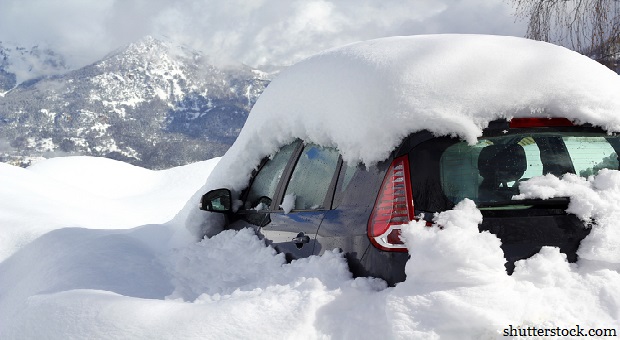When people think about problems that occur when driving in the snow, they usually limit their considerations to skidding or hitting a snow bank.
Oddly enough, many people that wind up in this situation cannot proceed because of other problems. This includes mechanical failure of the vehicle, loss of visibility, or a problem with the driver. Even if you are just outside of a city or town, that does not mean you can get to a place of safety by walking.
Having a viable plan and basic tools for surviving in the snow is very important.
Life Expectancy When Stuck in the Snow
One of the hardest things to accept is that being stuck in the snow is a very serious emergency. It does not matter whether you skidded into a snowbank, your tires became jammed with ice, or you are in white out conditions and simply can’t go any further safely.
If you do not maintain a safe body temperature, remain hydrated, and control skin moisture, you will die in about an hour. On a brighter note, if you take the right steps and have a few simple, relatively cheap items onhand, you can live for several weeks either inside the vehicle or a location nearby.
Even if the temperatures approach zero degrees, you can still survive until help arrives or you are able to travel to a safe location.
15 Items You Must Have
Aside from routine vehicle EDC items such as a pocket knife, seat belt cutter, flares, fire starting kit, rope/paracord, first aid kit, and cell phone; there are some things that you should always have on hand if you are going to travel during the winter months.
As you review this list, you may also want to add two backpacks so that you will have an easier time keeping all of the supplies sorted out and ready to move around as needed.
If you wind up stranded for more than 24 – 48 hours, there is a chance that the weather will clear enough for you to leave the vehicle. Under these circumstances, it will be much easier if you have a second backpack ready to go instead of trying to figure out what you have left.
Dividing your supplies in half will also make it easier to gauge how much you are using. Remember, you will have very little room inside the vehicle for repacking or sorting out inventory. This is the easiest way to make sure you have a good array of supplies ready for travel.
Metal spade – this is easily the most overlooked item to keep with you during the snowy months. If you are on a road that get plowed, or near a snow bank, your hands, and even plastic shovels will be useless for moving packed snow and ice.
A metal spade is also very useful for knocking out snow from around the tires and places where it may be building up in the wheel wells. When choosing a metal spade, try to get one with a good sturdy wooden handle.
If you decide to leave the vehicle, the shaft can make a good walking stick and stabilizer for when you need to walk across ice.
Snow shovel – necessary for keeping snow from building up around the doors and tailpipe. During an average snowfall, you will more than likely need to clear the area around the car every 3 – 4 hours. Both metal spades and snow shovels can also be very useful if you cannot shelter in the vehicle.
You can use these devices to dig out a pit in deeper snow as well as for constructing wind breaks and snow shelters.
Food and water for at least 5 days – choose nutrient dense, high calorie foods. I like to keep at least 70% foods that are ready to eat “as is” and 30% that can also be warmed up.
5 – 10 gallons of gasoline – absolutely necessary if you need to stay in the vehicle for more than 24 hours. Even at an idle, gasoline consumption will vary considerably from vehicle to vehicle, as will the amount of gas that you have onhand when you get stuck.
For smaller, more efficient vehicles, 5 gallons should get you through 2- 3 days. If you are driving a truck or a gas guzzler, try to store away 10 gallons.
Emergency blanket – There are two kinds of emergency blankets to choose from. First, you should always have the silver emergency blankets onhand. If possible, try to have some wool or other heavy material blankets.
You can also purchase flannel blankets that have 12v heating tapes in them. These blankets may be useful for providing heat faster during times when you are idling the vehicle. Just remember they can put a lot of drain on the electrical system.
At least one set of spare clothes plus waterproof, insulated boots – even if you routinely drive around in bare feet, stockings, or socks, you need sturdy, waterproof boots to manage being stuck in the snow. Remember, you will have to go out every few hours to clear snow from the doors and tail pipe.
Frostbite can set in within just a few minutes. Since you will not be able to treat this problem easily, the best thing you can do is avoid it by keeping your feet warm and dry while carrying out maintenance tasks.
At least six pair of dry socks – essential because your feet will sweat a great deal when you are working. Six pair will give the wet ones time to dry and ensure your feet stay as healthy as possible.

Boards, kitty litter/rock salt – if you are stuck in a snow bank, but the vehicle is still drivable, these items will improve traction and help you get back on the road.
Crank radio – reduce drain on the vehicle battery as much as possible by using a crank radio. Most radios of this type also have a flashlight, so it will serve a double purpose.
Spare, fully charged car battery – even though idling your vehicle will still charge up the battery, it never hurts to have a spare. In addition, if you cannot start the vehicle or decide to build a shelter away from it, you will still have a source of electricity.
Blaze color flags or strips and dowels – many sources say you should activate the hazards on your vehicle so that others can see it. Unfortunately, if the battery is already worn, or you have other needs, it may not be possible to keep them going.
Use blaze orange, pink, yellow, or green strips on dowels to mark out where your vehicle is. If you decide to leave the vehicle, you can also set the dowels into the snow so that rescuers can follow and have a better chance of finding you.
Propane, Sterno, or rubbing alcohol stove and fuel – remember not to use these inside the vehicle so that you do not wind up with toxic fumes building up.
Hand warmers and hot water bottle – chemical hand warmers can last for several hours and make it possible to get some rest. Melting and boiling water from snow to fill hot water bottles can also be helpful.
Plenty of towels or moisture absorbers – even if you have good quality boots and heavy gloves, rest assured snow and ice will get onto your skin. Towels and moisture are essential for preventing frost bite and other skin breakdowns.
Metal bucket for gathering and melting snow
5 Things You Need to do Immediately
Once you realize that you cannot proceed on your journey, you will need to secure your safety. If the vehicle crashed, that may entail taking a number of steps before you even consider figuring out how you will stay warm. For example, you may still need to cut yourself free of the seat belt, get into an upright position, or get yourself out of the vehicle through a window.
In a similar fashion, even if your vehicle did not crash, you will still need to do the following things before you hunker down and focus on staying warm and dry until it becomes possible to get to another location.
- Get out of the vehicle – In the event of a crash, look for leaking fluids, and also to see if there is anything that would keep the vehicle from being put back on the road. If you find fluids, it is not likely you will be able to safely restart the vehicle and use the engine as a source of heat. Let’s say you discover a coolant leak. There may or may not be enough left in the system to make it worth repairing the leak and trying to restart the engine. Unless you have some spare coolant onhand, it will not be safe to restart the engine. No matter how dire the circumstance may be, do not try to refill the coolant system with melted snow. Even if there is some antifreeze left in the system, there may not be enough to keep the larger amount of water from freezing. This, in turn can spell disaster if the temperature is below 32 degrees F. Once you go below this temperature, water expands as it forms into ice, which can cause hoses to burst, leaks in the radiator, and damage to the water pump and engine block.
Even if you cannot start the vehicle, you may still be able to use it for shelter as long as there are no obvious odors from leaked fluids. Under these circumstances, do not re-enter the vehicle until the engine is completely cool and you are certain there is no danger of explosion or fire.
- Take Care of Injuries – If your vehicle crashed, take time to make sure you address cuts, bruises, fractures, or any other injury that needs attention.
- Try to Make Sure the Car Won’t Get Hit – once you are physically stabilized, take a survey of where your vehicle actually is in relation to the road. If at all possible, try to push it to a place where it is less likely to get hit.
- If the vehicle is stable and safe, bring Supplies into the vehicle cabin
- Call for Assistance – if you usually keep the GPS tracking off on your phone, do not forget to turn it on before making this call.
- Setup and Activate Signals – you can use flares, blaze colors, and your hazards to alert other people to your location, and also to help them avoid hitting your vehicle.
Ways to Stay Warm
Most people will start off by saying the best thing you can do is keep the vehicle’s engine running. You can do this in 15- 20 minute increments, however you must still make sure you have sufficient ventilation to prevent carbon monoxide build up inside the cabin. Aside from making sure the tailpipe is clear, be sure to leave one or more windows cracked open to improve air flow.
In my personal experience, the short time that you can idle the vehicle isn’t the most efficient, or the best way to stay warm when stuck in the snow. While you may be able to use this method for a few hours to a few days, there are other things to try.
It is worthwhile to have a 12 volt blanket that will heat up in just a few minutes while you are idling the engine. In this case, you will have enough warmth in 5 – 10 minutes, which is a considerable savings over heating up the whole cabin.
The heat will also last longer right where you need it most. Once the blanket is disconnected from the power source, cover it over with a contractor trash bag to improve heat retention.
Consuming warm foods is also an important way to maintain core body temperature. For this, I recommend heating food up on the engine block while idling.
This will help give you a chance to get some exercise, warm up the interior of the vehicle, and get a hot meal at the same time.
If you already have water stored in a hot water bottle, this is also a good time to warm up the water so you can take it into the vehicle and use it under the blanket. I also like to use the chemical hand warmers under a layer of blankets.

These can give off heat safely and efficiently for several hours. This makes them ideal for short sleep intervals as well as for staying warm without using so much gas.
Depending on outdoor temperatures and the capacity to build a shelter, you can also use propane, Sterno, or rubbing alcohol stoves to keep warm. If you can start a fire using natural resources, then it can also be used for cooking.
That being said, don’t expect to be lucky enough to find fire wood or other viable materials in this kind of situation. It is better to keep secondary heat sources and fuel onhand in case you cannot use the vehicle’s engine.
Things You Must Never Do When Stuck in the Snow
When you get stuck in the snow, your instincts may be telling you to curl up into a tight ball or sit still. This will not help warmth circulate through your body. It will also prevent your body from building up heat from exercise.
Therefore, the worst thing you can do when stuck in the snow is to sit still or stay physically inactive. Shake your legs and feet, shovel snow away from the vehicle, and do everything you can to move as much as possible.
Do not forget to consume high calorie foods so that you have enough energy to generate heat. It is also very important to drink extra water. This will make it easier for your body to generate heat as well as maintain a viable temperature.
Regardless of how quickly or slowly the snow is coming down, it can build up around the tailpipe and doors faster than expected. Even if you only shut off the engine less than a half hour ago, be sure to inspect the tailpipe and make sure there is plenty of room around it.
Lack of space around the tailpipe can make it very easy for the exhaust to feed back under the vehicle and right up into the cabin. To add insult to injury, open windows will not be of much use in this situation because the exhaust will also get into the cabin via that route.
Death from carbon monoxide poisoning can occur in a matter of minutes.
Have you ever noticed how quiet everything is when snow is falling? If so, then you also know how easy it can be to fall asleep, especially if you are stuck in a vehicle. While getting sufficient rest is very important, do not fall asleep unless you have a safe heat source to work with such as hand warmers or something else that will not start a fire or cause a toxic exhaust buildup.
You should also set an alarm to wake you up every 45 minutes to 1 hour just to be on the safe side.
Making the Decision to Leave Your Vehicle
Most people will tell you that it is best to stay with your vehicle until someone comes to rescue you. This makes sense if you are too far from a building that can offer suitable shelter, or if the temperatures and rate of snowfall make it unsafe to travel on foot.
If you cannot travel the required distance on foot in optimal conditions, do not try to do so in the snow. Even six inches of snow can be hard to walk through, especially if you aren’t accustomed to it or are not in good physical condition.
When considering if you should leave the vehicle, it is also important to assess the expected weather conditions while you will be on foot. Make sure that you pay careful attention to updated radio broadcasts. Even though conditions may look suitable, bands of snow or an increase in winds can lead to a deadly situation if you are unable to reach shelter in time.
If at all possible, look for a stable weather window that is three times longer than what it would take for you to walk under optimal conditions.
Getting stuck in the snow is one of those emergencies that you may not give much thought to. Given how quickly hypothermia and death can occur in this kind of situation, it is very important to make sure you have the tools and skills required to manage this situation.
Without being prepared for a snow emergency, you should not be on the road, even if you are an experienced winter driver and have never gotten stuck before.
That being said, once you have a viable emergency plan and gear in place, it will make it easier for you to travel in these conditions during a major social collapse as well as in more routine circumstances.























































































You tell us to not drink alcohol yet you have recipes for alcohol drinks embedded in the main body of article. Why the discrepancy? Where am I supposed to keep all this equipment? Hauling ten gallons of gas is a very bad practice due to fire and odor. Getting hit in the rear is a common accident in snow and ice. if you went off road, there will probably be other cars driving foolishly at higher speeds and will hit you in the rear; boom is the last explosion you will her as you slowly burn to death. Having extra batteries for your cell phone is my first choice in survival. you should always keep your gas tank 1/2 full in the winter. Yes, it is a hassle to keep extra gas in your tank but it could be your life saver. In winter towing companies are hard hit for keeping up with with the calls coming in. I used to work as a helper to tow drivers and we were sometimes 3 days booked out for minor accident recovery in an effort to keep up with law enforcement primary accidents.. many ideas in this article are great but watch out for anything regarding gas and extra car battery. Failure to keep it charged is a real problem as it is just extra weight to haul around.
Could you provide links to the types of blankets you suggest? Thanks.
It would make sense if you have a tarp, at lease 8×10+ to drape it over the tailgate, using the grommets and some para-cord to tie it to the roof rack of a SUV type car so that you can get out and stand up outside of the vehicle underneath the rear hatch door within the space of the tailgate. Depending the width of the tarp, the overhang may block some of the snow from the sides, Yes, it will let the cold in, but the side doors may become blocked with snow, trapping you. It can also be used for your bathroom needs, then just cover the mess over. I used this concept 40 years ago while camping, extending the usable area of my VW Squareback and staying dry, and it worked just find.
By the time you pack all that extra stuff into your car, you won’t have room for passengers lol
I left a comment a few days ago but it was partially negative and I don’t see IT listed.